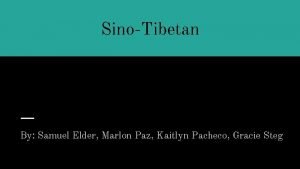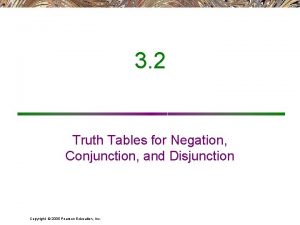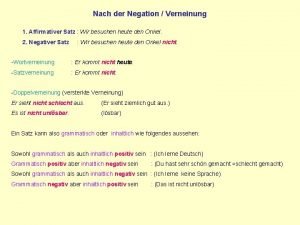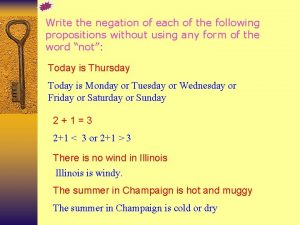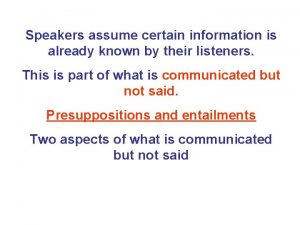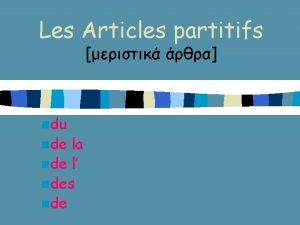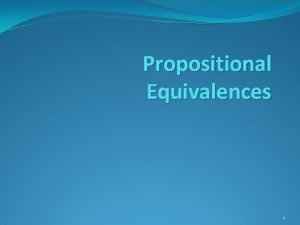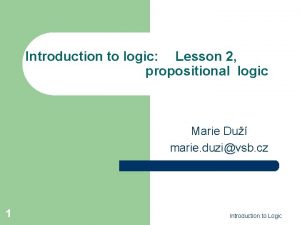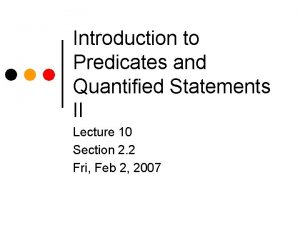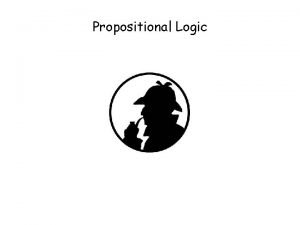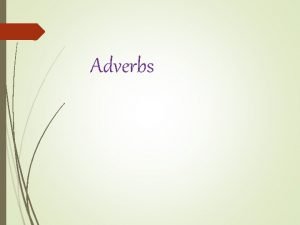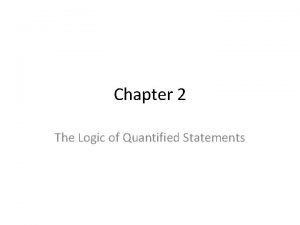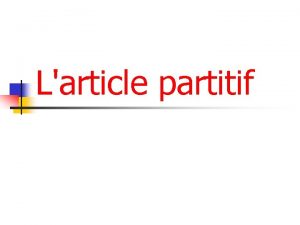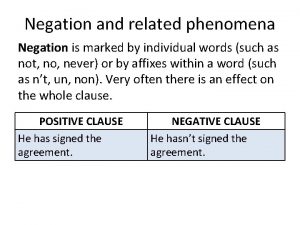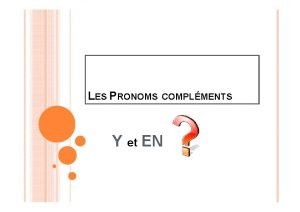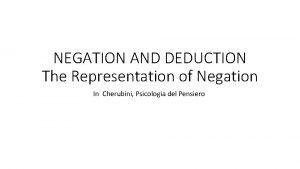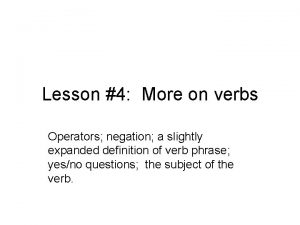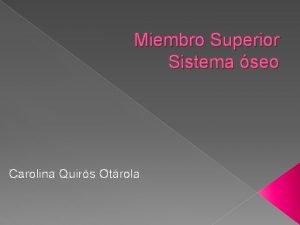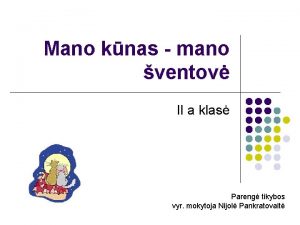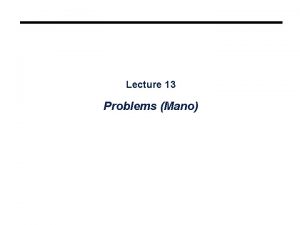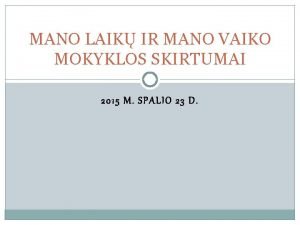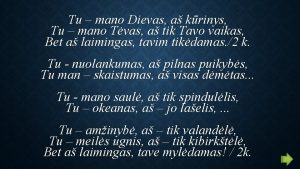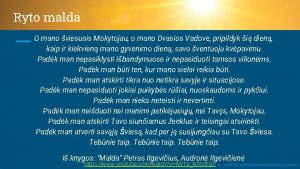Negation in Mano Southern Mande Workshop Negation SWL2018































- Slides: 31

Negation in Mano, Southern Mande Workshop “Negation”, SWL-2018, Paris, France Masha Khachaturyan University of Helsinki maria. khachaturyan@helsinki. fi


Basic background details Mano < Southern Mande < Niger-Congo ~400 000 speakers in Guinea and Liberia Three tones, rich grammatical tones, especially in verbs S – AUX – O – V – X AUX: TAMP + indexing of subject (person and number), pro-drop “linear” TAMP systems (Welmers 1973: 343): the expression of specific TAMP values is not located in specific markers: it is rather expressed by a construction as a whole which contains auxiliaries together with predicative markers, particles, adverbs and verbs in a particular morphological form • negation is expressed in copulas, in auxiliaries and in additional predicative markers which are used in certain negative constructions • • •

Main TAMP constructions in Mano


Copulas and auxiliaries • Affirmative copulas: lɛ (general), wɔ (presentative, visible/invisible), gɛ (presentative, visible) • Negative copula: wɔ • Series of auxiliaries: EXI (existential), PST (past), PRF (perfect), IPFV (imperfective), CONJ (conjunctive), NEG (negative), PROH (prohibitive), SUBJ (subjunctive), PROSP (prospective), DUB (dubitative)

Non-verbal predications-1

Non-verbal predications-2

Imperfective

Presentatives • Three affirmative copulas used in affirmative presentative • Semantic incompatibility in negative presentatives

Resultatives • Affirmative resultative: affirmative copula • Negative resultative: negative copula, but different construction

Non-verbal predications + imperfective + resultative: summary • affirmative: existential auxiliary, person and number distinctions; affirmative copulas • negative: negative copula

Negation in declaratives More aspectual distinctions in affirmative declaratives:

Asymmetry in declaratives

Negation in non-declaratives

Negation in dependent clauses: relative clauses

Bonus interesting features • Dedicated negation marker in irrealis conditional clauses • Split between full and partial negation in indefinite pronouns.

Negative conditionals (irrealis)

Negation and indefinite pronouns Semantic map of quantifiers from (Tatevosov 2002)

Indefinite pronouns indirect negation

Indefinite pronouns direct negation

Comparative

• Haspelmath 1997, Tatevosov 2002: consider only contexts where negation has a scope over the indefinite marker: nobody came = there does not exist anyone that came • Similarly, in the «comparative» context: he works better than anyone = every person is such that he works better than him. (why this restriction? )

New semantic map of quantifiers I suggest integrating the values of partial comparative and partial direct negation into the semantic map.

• Consider Russian –nibud’, which is also used in contexts with direct partial negation and partial comparative: Navernoe, kto-nibud’ ne soglasitsa, no rech ne ob etom. Perhaps, someone will not agree/*no one will agree, but it does not matter. Navernoe, nikto ne soglasitsa. Perhaps, no one will agree. On rabotaet luchshe kogo-nibud’, no ne vseh. He works better than someone, but not everyone.

At the same time, Russian –nibud’ is used (against the data in Haspelmath) in contexts of • free choice Vozmi kakoy-nibud’! Take one (anyone)! • Indirect negation Ya ne znau, prishol li kto-nibud’. I do not know whether someone came.

A new semantic map for –nibud’

A map for Mano do o and gbu u

Summary • Negation in Mano is asymmetric: • constructional asymmetry: suppletive paradigms of affirmative and negative markers, different structures of affirmative and negative constructions • paradigmatic asymmetry: the inventory of negative constructions and markers is reduced with respect to the inventory of affirmative constructions and markers • Different behavior in dependent clauses • A dedicated highly specified negative marker: negative irrealis (used in irrealis conditional clauses) • Distinction between indefinite pronouns used for partial and full direct negation (perhaps, a useful observation for the typology of indefinite pronouns in general)

Thank you!

References • Haspelmath, M. (1997). Indefinite pronouns. Oxford: Oxford University Press. • Miestamo, M. (2005). Standard Negation: The Negation of Declarative Verbal Main Clauses in a Typological Perspective. Walter de Gruyter. • Tatevosov, S. (2002). Semantika sostavlyayushiy imennoy gruppy: kvantornye slova. Moscow: IMLI RAN. • Welmers, W. E. (1973). African language structures. Berkeley: University of California Press.
 Bibliografía antonio machado
Bibliografía antonio machado Mande speakers
Mande speakers Asl 184
Asl 184 Verbe pronominal se laver
Verbe pronominal se laver Converse symbolic notation
Converse symbolic notation Conjunction truth table
Conjunction truth table Negation
Negation Symbolic proposition
Symbolic proposition What is the negation of each of these propositions
What is the negation of each of these propositions Difference between presupposition and entailment
Difference between presupposition and entailment Skopus definition
Skopus definition Articles partitifs
Articles partitifs What is a wff in logic
What is a wff in logic Logical equivalence
Logical equivalence Tense logic
Tense logic Negation of a quantified statement
Negation of a quantified statement 17 verbes avec être
17 verbes avec être Not p then q
Not p then q Negation adverb
Negation adverb Universal conditional statement examples
Universal conditional statement examples Predicate negation
Predicate negation Partitif
Partitif Marked for negation
Marked for negation Examples of pragmatics
Examples of pragmatics Pronom
Pronom A whale is not a fish negation
A whale is not a fish negation Negation paragraph
Negation paragraph Negation of a and b
Negation of a and b Négation allemand
Négation allemand Operator verb example
Operator verb example Otrola
Otrola Naa mano nethramu therachi
Naa mano nethramu therachi

